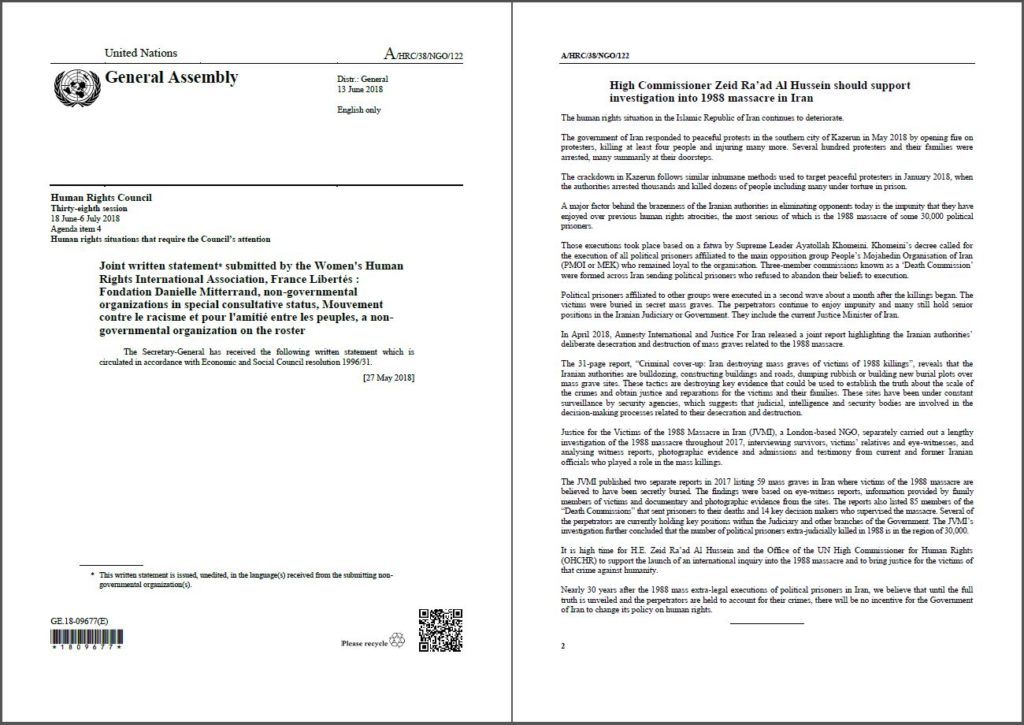Several non-governmental organisations with consultative status at the United Nations have once again urged High Commissioner Zeid Ra’ad Al Hussein to support an international investigation into the 1988 massacre of political prisoners in Iran. The text of the NGOs’ joint written statement to the 38th session of the UN Human Rights Council was published and circulated by the UN on 13 June 2018 as document A/HRC/38/NGO/122.
The joint written statement is available on the UN website: http://undocs.org/A/HRC/38/NGO/122
The following is the full text of the joint written statement:
Human Rights Council
Thirty-eighth session
18 June-6 July 2018
Agenda item 4
Human rights situations that require the Council’s attention
Joint written statement submitted by the Women’s Human Rights International Association, France Libertés : Fondation Danielle Mitterrand, non-governmental organizations in special consultative status, Mouvement contre le racisme et pour l’amitié entre les peuples, a non-governmental organization on the roster
High Commissioner Zeid Ra’ad Al Hussein should support investigation into 1988 massacre in Iran
The human rights situation in the Islamic Republic of Iran continues to deteriorate.
The government of Iran responded to peaceful protests in the southern city of Kazerun in May 2018 by opening fire on protesters, killing at least four people and injuring many more. Several hundred protesters and their families were arrested, many summarily at their doorsteps.
The crackdown in Kazerun follows similar inhumane methods used to target peaceful protesters in January 2018, when the authorities arrested thousands and killed dozens of people including many under torture in prison.
A major factor behind the brazenness of the Iranian authorities in eliminating opponents today is the impunity that they have enjoyed over previous human rights atrocities, the most serious of which is the 1988 massacre of some 30,000 political prisoners.
Those executions took place based on a fatwa by Supreme Leader Ayatollah Khomeini. Khomeini’s decree called for the execution of all political prisoners affiliated to the main opposition group People’s Mojahedin Organisation of Iran (PMOI or MEK) who remained loyal to the organisation. Three-member commissions known as a ‘Death Commission’ were formed across Iran sending political prisoners who refused to abandon their beliefs to execution.
Political prisoners affiliated to other groups were executed in a second wave about a month after the killings began. The victims were buried in secret mass graves. The perpetrators continue to enjoy impunity and many still hold senior positions in the Iranian Judiciary or Government. They include the current Justice Minister of Iran.
In April 2018, Amnesty International and Justice For Iran released a joint report highlighting the Iranian authorities’ deliberate desecration and destruction of mass graves related to the 1988 massacre.
The 31-page report, “Criminal cover-up: Iran destroying mass graves of victims of 1988 killings”, reveals that the Iranian authorities are bulldozing, constructing buildings and roads, dumping rubbish or building new burial plots over mass grave sites. These tactics are destroying key evidence that could be used to establish the truth about the scale of the crimes and obtain justice and reparations for the victims and their families. These sites have been under constant surveillance by security agencies, which suggests that judicial, intelligence and security bodies are involved in the decision-making processes related to their desecration and destruction.
Justice for the Victims of the 1988 Massacre in Iran (JVMI), a London-based NGO, separately carried out a lengthy investigation of the 1988 massacre throughout 2017, interviewing survivors, victims’ relatives and eye-witnesses, and analysing witness reports, photographic evidence and admissions and testimony from current and former Iranian officials who played a role in the mass killings.
The JVMI published two separate reports in 2017 listing 59 mass graves in Iran where victims of the 1988 massacre are believed to have been secretly buried. The findings were based on eye-witness reports, information provided by family members of victims and documentary and photographic evidence from the sites. The reports also listed 85 members of the “Death Commissions” that sent prisoners to their deaths and 14 key decision makers who supervised the massacre. Several of the perpetrators are currently holding key positions within the Judiciary and other branches of the Government. The JVMI’s investigation further concluded that the number of political prisoners extra-judicially killed in 1988 is in the region of 30,000.
It is high time for H.E. Zeid Ra’ad Al Hussein and the Office of the UN High Commissioner for Human Rights (OHCHR) to support the launch of an international inquiry into the 1988 massacre and to bring justice for the victims of that crime against humanity.
Nearly 30 years after the 1988 mass extra-legal executions of political prisoners in Iran, we believe that until the full truth is unveiled and the perpetrators are held to account for their crimes, there will be no incentive for the Government of Iran to change its policy on human rights.

